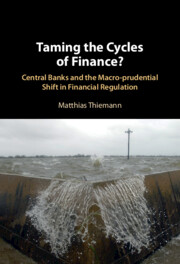Book contents
- Taming the Cycles of Finance?
- Taming the Cycles of Finance?
- Copyright page
- Contents
- Figures
- Tables
- Prologue
- Acknowledgments
- 1 Introduction
- 2 The Changing Regulation of Finance after the Crisis
- 3 The Evolution of Systemic Risk Thinking Pre-crisis
- 4 The Selective Rise of Macro-prudential Ideas in the Wake of the Crisis
- 5 Is Resilience Enough?
- 6 From the Global to the Local
- 7 Taming Liquidity and Leverage in the Shadow Banking Sector
- 8 Into the Upswing
- 9 The Crisis That Wasn’t
- 10 Conclusion
- Appendix: List of Interviews Conducted
- References
- Index
6 - From the Global to the Local
Enacting the Countercyclical Capital Buffer through the Creation of Early Warning Systems
Published online by Cambridge University Press: 15 February 2024
- Taming the Cycles of Finance?
- Taming the Cycles of Finance?
- Copyright page
- Contents
- Figures
- Tables
- Prologue
- Acknowledgments
- 1 Introduction
- 2 The Changing Regulation of Finance after the Crisis
- 3 The Evolution of Systemic Risk Thinking Pre-crisis
- 4 The Selective Rise of Macro-prudential Ideas in the Wake of the Crisis
- 5 Is Resilience Enough?
- 6 From the Global to the Local
- 7 Taming Liquidity and Leverage in the Shadow Banking Sector
- 8 Into the Upswing
- 9 The Crisis That Wasn’t
- 10 Conclusion
- Appendix: List of Interviews Conducted
- References
- Index
Summary
Chapter 6 traces the implementation of the most prominent anti-cyclical element into the global regulatory overhaul post-crisis, namely the countercyclical capital buffer, the only anti-cyclical regulatory tool in the global Basel III regulation. As I show, operationalizing this tool and executing the countercyclical mandate required the creation of robust early warning systems that could detect and signal the buildup of cyclical systemic risks sufficiently ahead of time in order to enable timely preventive action. The chapter traces the work of applied economists in the three central banks under study, showing how their decade-long research effort provided such monitoring frameworks, which not only provided robust signals but also shifted the academic scientific discourse on this issue, providing the stylized facts that challenged a sanguine view of financial markets. The study at the same time finds that these early warning frameworks were often implemented in the design of stress tests, allowing central bank policymakers to engage in discretionary countercyclical action without overtly exposing themselves to the politicization of these acts.
Information
- Type
- Chapter
- Information
- Taming the Cycles of Finance?Central Banks and the Macro-prudential Shift in Financial Regulation, pp. 132 - 164Publisher: Cambridge University PressPrint publication year: 2024
